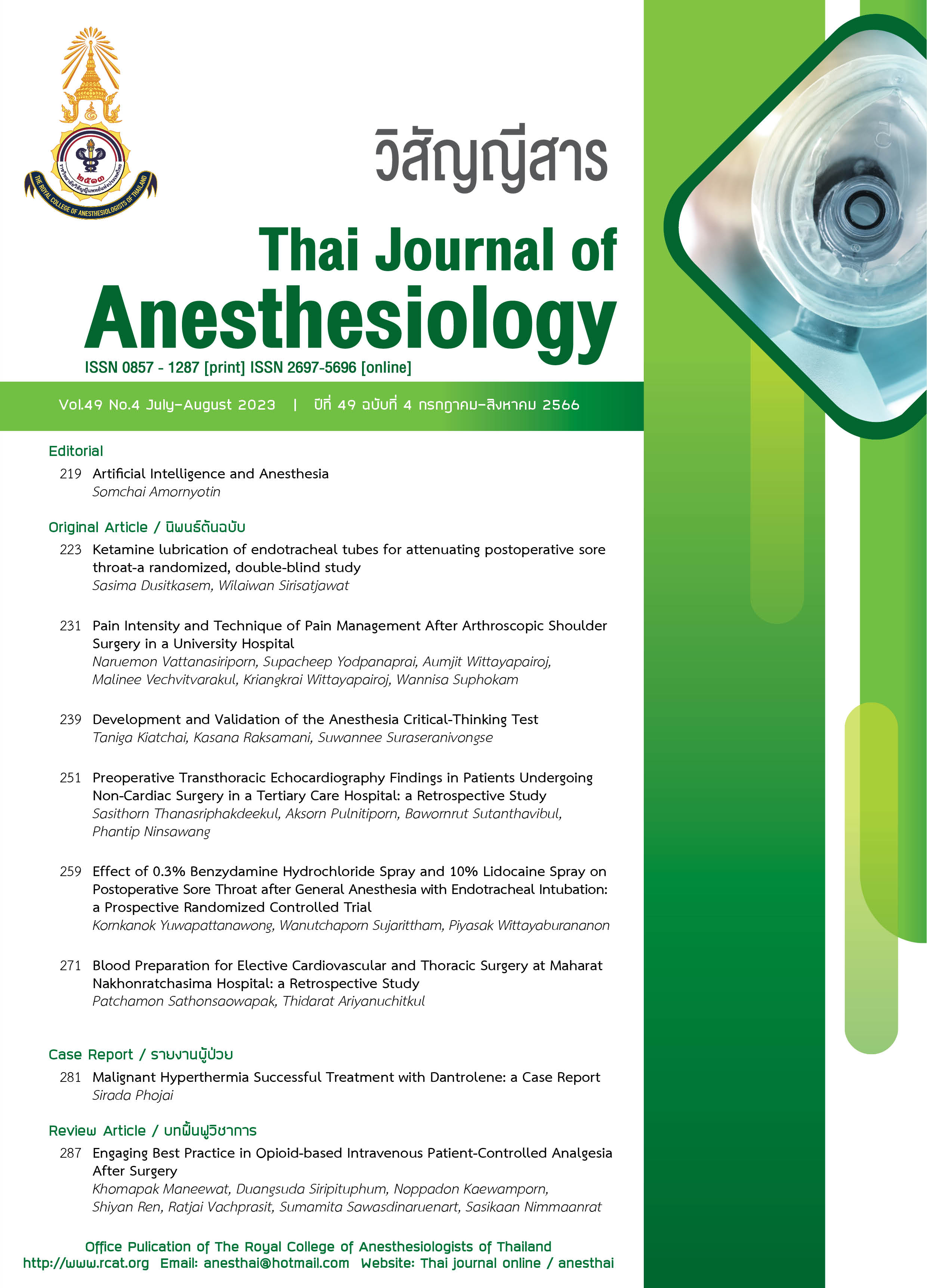Pain Intensity and Technique of Pain Management After Arthroscopic Shoulder Surgery in a University Hospital
Main Article Content
Abstract
Background: Arthroscopic shoulder surgery (ATS) is a minimally invasive procedure used to diagnose and treat shoulder pathologies. Although small incisions were created, the damage to inside tissue, ligaments, and joints surface resulted in considerable postoperative pain. Effective pain management is essential for early rehabilitation, rapid recovery, shortens hospital stay and improves patient satisfaction. This study is aimed to evaluate the pain intensity and efficacy in pain management after various types of ATS in our hospital. Materials and methods: This retrospective descriptive study was conducted using the database in our hospital. After approval by the institutional ethics committee, we extracted data from patients undergoing ATS between January 1, 2019, and December 31, 2021, who had aged over 18 years and ASA physical status I-III. Patient demographics, type of surgery, anesthetic and analgesia techniques, postoperative pain scores, and opioid-related side effects were collected. Results: During the study period, there were 101 patients scheduled for ATS. Eighty-nine patients met the inclusion criteria. Most of the patients in this study were males (59.6%), undergoing rotator cuff repair surgery (53.0%) and receiving the technique of general anesthesia (79.0%) for surgery. About half of the patients who arrived at the post-anesthesia care unit (PACU) revealed severe pain. The effective technique for immediate pain control was interscalene block (ISB), followed by the local infiltration analgesia technique. Conclusion: ATS surgery can cause significant postoperative pain. The ISB technique provides adequate analgesia and reduces opioid consumption during surgery and in the PACU.
Article Details

This work is licensed under a Creative Commons Attribution-NonCommercial-NoDerivatives 4.0 International License.
References
Rao AG, Yokota A, McFarland EG. Shoulder arthroscopy: principles and practice. Phys Med Rehabil Clin N Am. 2004;15:627-42.
Farmer KW, Wright TW. Shoulder arthroscopy: the basics. J Hand Surg Am. 2015;40:817-21.
Gerbershagen HJ, Aduckathil S, van Wijck AJ, Peelen LM, Kalkman CJ, Meissner W. Pain intensity on the first day after surgery: a prospective cohort study comparing 179 surgical procedures. Anesthesiology. 2013;118:934-44.
Toma O, Persoons B, Pogatzki-Zahn E, et al. PROSPECT guideline for rotator cuff repair surgery: systematic review and procedure-specific postoperative pain management recommendations. Anaesthesia. 2019;74:1320-31.
Helander EM, Menard BL, Harmon CM, et al. Multimodal analgesia, current concepts, and acute pain considerations. Curr Pain Headache Rep. 2017;21:3.
Calvo E, Torres MD, Morcillo D, Leal V. Rotator cuff repair is more painful than other arthroscopic shoulder procedures. Arch Orthop Trauma Surg. 2019;139:669-74.
Yan S, Zhao Y, Zhang H. Efficacy and safety of interscalene block combined with general anesthesia for arthroscopic shoulder surgery: a meta-analysis. J. Clin. Anesth. 2018;47:74-9.
Chen HP, Shen SJ, Tsai HI, Kao SC, Yu HP. Effects of interscalene nerve block for postoperative pain management in patients after shoulder surgery. Biomed Res Int. 2015;2015:902745.
Lehmann LJ, Loosen G, Weiss C, Schmittner MD. Interscalene plexus block versus general anaesthesia for shoulder surgery: a randomized controlled study. Eur J Orthop Surg Traumatol. 2015;25:255-61.
Hewson DW, Oldman M, Bedforth NM. Regional anaesthesia for shoulder surgery. BJA Educ. 2019;19:98-104.
Aszmann OC, Dellon AL, Birely BT, McFarland EG. Innervation of the human shoulder joint and its implications for surgery. Clin Orthop Relat Res. 1996;330:202-7.
Bishop JY, Sprague M, Gelber J, et al. Interscalene regional anesthesia for arthroscopic shoulder surgery: a safe and effective technique. J Shoulder Elbow Surg. 2006;15:567-70.
Kang R, Jeong JS, Chin KJ, et al. Superior trunk block provides noninferior analgesia compared with interscalene brachial plexus block in arthroscopic shoulder surgery. Anesthesiology. 2019;131:1316-26.
Aliste J, Bravo D, Layera S, et al. Randomized comparison between interscalene and costoclavicular blocks for arthroscopic shoulder surgery. Reg Anesth Pain Med. 2019;44:472-7.
Hussain N, Goldar G, Ragina N, Banfield L, Laffey JG, Abdallah FW. Suprascapular and interscalene nerve block for shoulder surgery: a systematic review and meta-analysis. Anesthesiology. 2017;127:998-1013.
Kissin I. Preemptive analgesia. Anesthesiology. 2000;93:1138-43.
Khalili G, Janghorbani M, Saryazdi H, Emaminejad A. Effect of preemptive and preventive acetaminophen on postoperative pain score: a randomized, double-blind trial of patients undergoing lower extremity surgery. J Clin Anesth. 2013;25:188-92.
Wheeler M, Oderda GM, Ashburn MA, Lipman AG. Adverse events associated with postoperative opioid analgesia: a systematic review. J Pain. 2002;3:159-80.
Urman RD, Seger DL, Fiskio JM, et al. The burden of opioid-related adverse drug events on hospitalized previously opioid-free surgical patients. J Patient Saf. 2021;17:76-83.
Oderda GM, Gan TJ, Johnson BH, Robinson SB. Effect of opioid-related adverse events on outcomes in selected surgical patients. J Pain Palliat Care Pharmacother. 2013;27:62-70.


